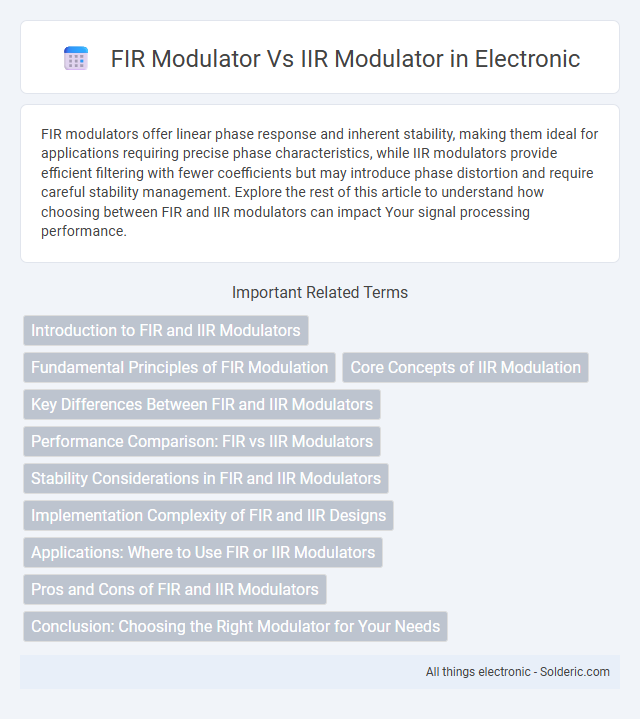FIR modulators offer linear phase response and inherent stability, making them ideal for applications requiring precise phase characteristics, while IIR modulators provide efficient filtering with fewer coefficients but may introduce phase distortion and require careful stability management. Explore the rest of this article to understand how choosing between FIR and IIR modulators can impact Your signal processing performance.
Comparison Table
| Feature | FIR Modulator | IIR Modulator |
|---|---|---|
| Filter Type | Finite Impulse Response (FIR) | Infinite Impulse Response (IIR) |
| Stability | Always stable | Potentially unstable |
| Phase Response | Linear phase | Non-linear phase |
| Complexity | Higher computational load | Lower computational load |
| Memory Requirement | More memory | Less memory |
| Design Flexibility | Easy to design, no feedback | Complex design due to feedback |
| Noise Shaping | Effective noise shaping with inherent stability | Better noise shaping, risk of limit cycles |
| Applications | High precision, linear phase requirements | Low power, real-time applications |
Introduction to FIR and IIR Modulators
FIR modulators, implemented using finite impulse response filters, provide inherent stability and linear phase characteristics, making them ideal for applications requiring precise signal shaping. IIR modulators rely on infinite impulse response filters, offering greater computational efficiency and sharper frequency responses but requiring careful design to avoid instability. Your choice between FIR and IIR modulators depends on the trade-off between performance accuracy and resource constraints in your signal processing system.
Fundamental Principles of FIR Modulation
FIR modulation relies on finite impulse response filters, which use a fixed number of coefficients to process input signals, ensuring inherent stability and linear phase response. This type of modulation achieves precise control over frequency components by applying a weighted sum of current and past input samples without feedback loops. FIR modulators excel in applications requiring predictable and distortion-free signal shaping due to their non-recursive structure.
Core Concepts of IIR Modulation
IIR modulators utilize infinite impulse response filters that feedback a portion of their output, enabling efficient representation of signals with fewer coefficients compared to FIR modulators. This feedback mechanism allows IIR modulators to achieve sharper frequency response characteristics with lower computational complexity. Your choice of modulation may benefit from the IIR structure's ability to provide compact filter designs and enhanced spectral shaping.
Key Differences Between FIR and IIR Modulators
FIR modulators use a finite number of coefficients with non-recursive structures, ensuring inherent stability and linear phase response, while IIR modulators employ recursive feedback loops, allowing a more compact design but potentially causing stability issues. FIR modulators typically provide better phase linearity and are easier to implement in hardware, whereas IIR modulators offer greater computational efficiency and sharper filter roll-off with fewer coefficients. Understanding these key differences helps you choose the right modulator type based on your specific performance and implementation needs.
Performance Comparison: FIR vs IIR Modulators
FIR modulators offer superior stability and linear phase response, making them ideal for applications requiring precise signal reconstruction with minimal distortion. IIR modulators provide higher computational efficiency and better frequency selectivity due to feedback loops, but can suffer from phase nonlinearity and potential instability. Choosing your modulator depends on whether you prioritize consistent performance and phase accuracy (FIR) or reduced processing complexity and sharper frequency response (IIR).
Stability Considerations in FIR and IIR Modulators
FIR modulators are inherently stable due to their non-recursive structure and finite impulse response, eliminating the risk of feedback-induced oscillations. IIR modulators, with recursive loops and infinite impulse response, require careful pole placement to maintain stability and prevent divergence. Stability in IIR modulators depends heavily on filter coefficient accuracy and implementation, making FIR modulators preferable for guaranteed stable modulation in critical systems.
Implementation Complexity of FIR and IIR Designs
FIR modulators generally have higher implementation complexity due to their longer filter lengths and non-recursive structure, requiring more multipliers and adders compared to IIR modulators. IIR modulators benefit from recursive feedback, enabling shorter filter lengths and fewer coefficients, which reduces computational load and hardware resource usage. However, FIR modulators provide inherent stability and linear phase response, while IIR modulators may require additional design effort to ensure stability and manage phase distortion.
Applications: Where to Use FIR or IIR Modulators
FIR modulators excel in applications requiring linear phase response and stable filtering, such as digital communication systems and audio signal processing, ensuring minimal phase distortion. IIR modulators are preferred in real-time signal processing tasks like control systems and biomedical signal analysis where computational efficiency and sharper frequency response are critical. Your choice depends on whether phase linearity or computational speed is more crucial for your specific application.
Pros and Cons of FIR and IIR Modulators
FIR modulators offer inherent stability and linear phase response, making them ideal for applications requiring precise phase characteristics, but they typically require higher computational resources than IIR modulators. IIR modulators provide efficient implementation with fewer coefficients, leading to lower computational complexity and faster processing, though they may introduce nonlinear phase distortion and potential stability issues. Your choice depends on balancing the need for phase linearity and computational efficiency in your modulation system.
Conclusion: Choosing the Right Modulator for Your Needs
FIR modulators offer linear phase response and inherent stability, making them ideal for applications requiring precise phase control and predictable behavior. IIR modulators provide efficient implementation with lower computational complexity, suitable for real-time systems where resource constraints are critical. Your choice depends on prioritizing phase linearity and stability with FIR, or computational efficiency and memory usage with IIR modulators.
FIR modulator vs IIR modulator Infographic

 solderic.com
solderic.com